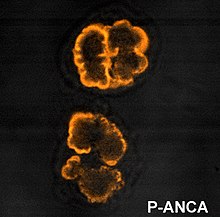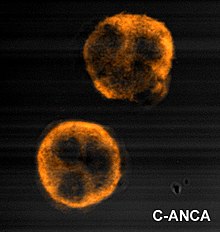


Anti-neutrophil cytoplasmic antibodies (ANCAs) are a group of autoantibodies, mainly of the IgG type, against antigens in the cytoplasm of neutrophils (the most common type of white blood cell) and monocytes. They are detected as a blood test in a number of autoimmune disorders, but are particularly associated with systemic vasculitis, so called ANCA-associated vasculitides (AAV).[1]
- ^ Sharma P, Zonozi R, Geetha D. ANCA-Associated Vasculitis. Adv Kidney Dis Health. 2024 May;31(3):194-205. doi: 10.1053/j.akdh.2024.04.005. PMID: 39004459.